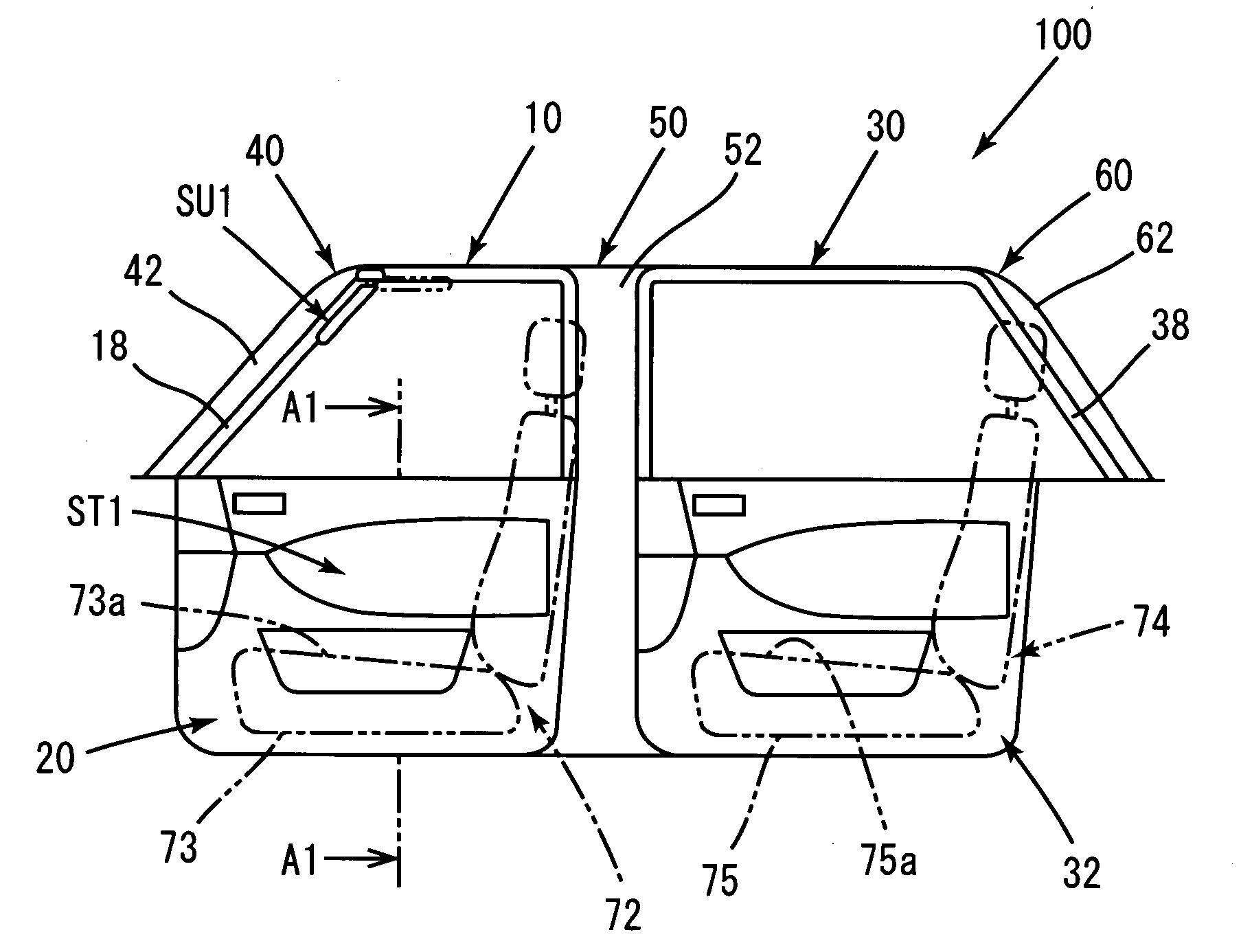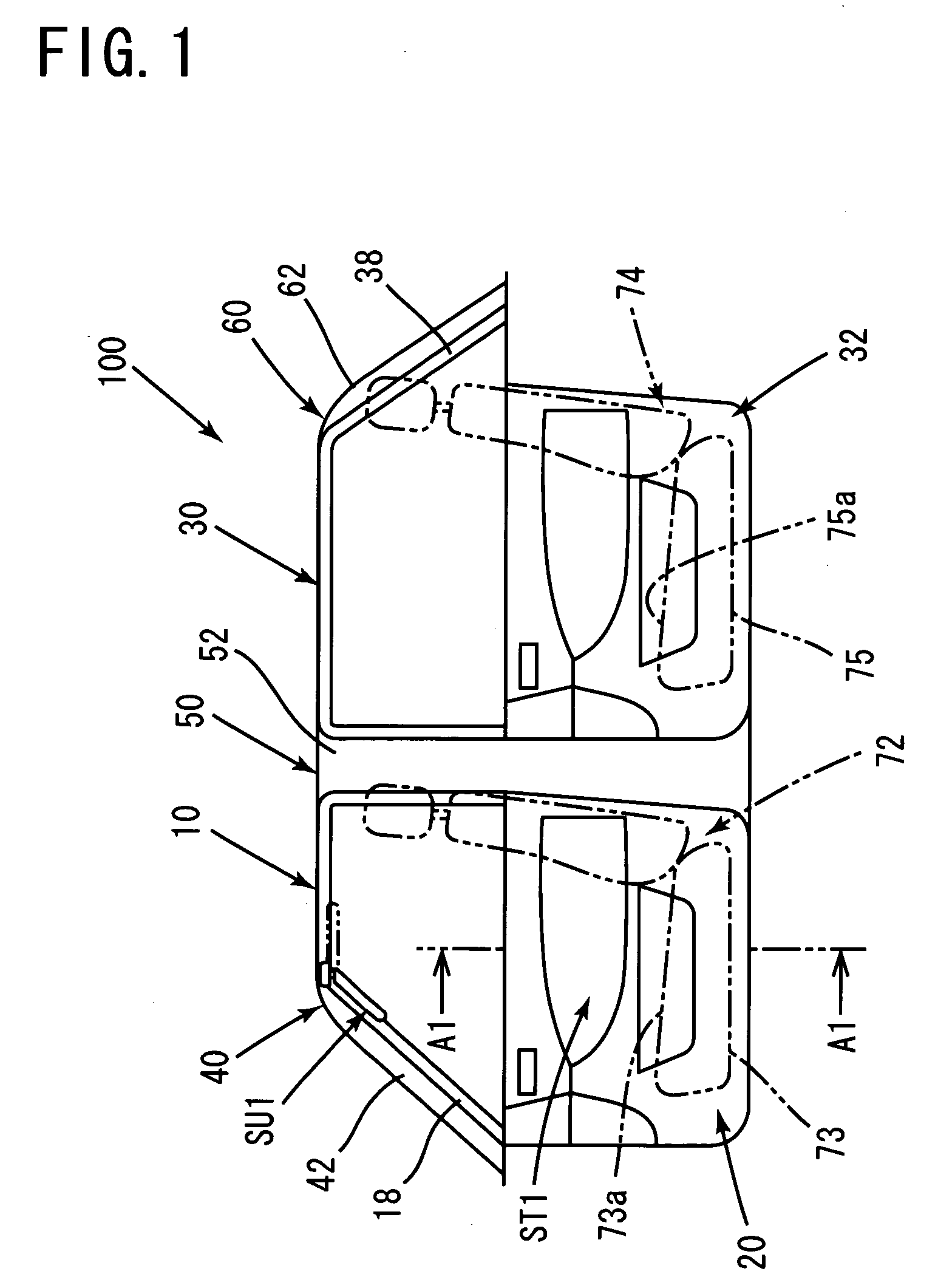Sun visor for automobile and sound absorbing structure for an automobile
- Summary
- Abstract
- Description
- Claims
- Application Information
AI Technical Summary
Benefits of technology
Problems solved by technology
Method used
Image
Examples
first embodiment
(1) First Embodiment
(1-1) Constitution of Sound Absorbing Structure for Automobile
[0092] In a driving seat door 10 of the road-running automobile, an interior base material 22 is provided on a cabin side of body panels 12, 14, and a recessed portion 23 is formed on the cabin side of the interior base material 22. A sound absorbing structure ST1 of the automobile is constituted by forming the recessed portion 23 on the cabin side of the interior base material 22, which forms a side face when seen by a passenger sitting on a seating portion 73, on the upper side of the seating surface 73, and burying a sound absorbing material 26 capable of absorbing sound in the recessed portion.
[0093] An automobile sun visor SU1 for protecting a passenger from glare is provided rotatably in the cabin interior. A spindle member 620 of the sun visor SU1 is attached and fixed to the ceiling of the cabin above the front window on the side window side. The spindle member 620 comprises an L-shaped meta...
second embodiment
(3) Second Embodiment
[0150]FIG. 8 is a vertical sectional view showing the main parts of a driving seat door from a position corresponding to A1-A1 in FIG. 1, and FIG. 9 is a side view showing a perforated sound absorbing material 126 from the same position as FIG. 1. In this embodiment, a perforated sound absorbing material 126 formed with through holes directly linking the cabin side and the vehicle exterior side is used instead of the sound absorbing material 26 of the first embodiment. The perforated sound absorbing material 126 shown in the drawing is formed with a plurality of through holes 127. In a sound absorbing structure ST2 of this embodiment, the perforated sound absorbing material 126 is buried in and fixed to the recessed portion 23, whereupon the main surface 22a of the interior base material and the perforated sound absorbing material 126 are covered continuously by the surface material 24 having high air permeability (low air resistance).
[0151] A depth L15 of the ...
first example
[0187] A polypropylene resin door trim base material with a thickness of 2.5 mm was used as the interior base material. The interior base material was formed by molding the door trim base material into a shape having a recessed portion in the central portion of the front door trim. The recessed portion was formed with a rectangular opening portion, a length L2 in the automobile front-rear direction of 600 mm, a length L3 in the automobile height direction of 300 mm, and an average depth of 20 mm.
[0188] A non-perforated sound absorbing material formed at an average thickness of 20 mm by binding recycled fibers using a binder without through holes linking the cabin side and vehicle exterior side was used as the sound absorbing material. The density of the non-perforated sound absorbing material was set at 0.12 g / cm3. The non-perforated sound absorbing material was buried in and fixed to the recessed portion in the interior base material.
[0189] Needle-punched nonwoven fabric made of ...
PUM
 Login to View More
Login to View More Abstract
Description
Claims
Application Information
 Login to View More
Login to View More - R&D
- Intellectual Property
- Life Sciences
- Materials
- Tech Scout
- Unparalleled Data Quality
- Higher Quality Content
- 60% Fewer Hallucinations
Browse by: Latest US Patents, China's latest patents, Technical Efficacy Thesaurus, Application Domain, Technology Topic, Popular Technical Reports.
© 2025 PatSnap. All rights reserved.Legal|Privacy policy|Modern Slavery Act Transparency Statement|Sitemap|About US| Contact US: help@patsnap.com



